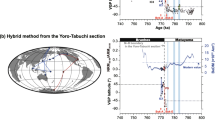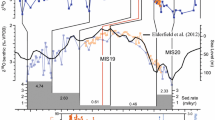Abstract
Paleomagnetic determinations on lithological profiles of two paralleled long drilling cores covering the past 130 kyr B.P., GT40 and GT60, from the Yanchi Playa in the arid Northwestern China, indicate that a series of pronounced paleomagnetic excursions have been documented. By correlating our results with published regional and worldwide reports, 4 excursion events out of 10 apparent reversal signals (labeled from GT-1 to GT-10) were identified as excursion events coeval with the Mono Lake Event (28.4 kyr–25.8 kyr), Laschamp Event (43.3 kyr–40.5 kyr), Gaotai Event (82.8 kyr–72.4 kyr) and the Blake Event (127.4 kyr–113.3 kyr), respectively. GT-9 correlates with the above-mentioned Gaotai Event, GT-7 and GT-6 correspond to two stages of the Laschamp Event and GT-5 to the Mono Lake Event. It is noteworthy that the so-called Gaotai Event has not been reported as a pronounced paleomagnetic excursion in the Northwestern China. Every magnetic excursion event corresponds to paleointensity minima, anteceding those established abrupt paleoclimatic change events, such as the Younger Drays and the Heinrich Events (H1–H6). Here, we tentatively propose that these geomagnetic excursions/reversals can be viewed as precursors to climate abruptness. During the transitional stages when the earth’s magnetic field shifted between a temporal normal and a negative period, the earth’s magnetic paleointensity fell correspondingly to a pair of minima. Although more precise chronology and more convincing rock magnetic parameter determinations are essentially required for further interpretation of their intricate coupling mechanism, these results may have revealed, to some extent, that the earth’s incessantly changing magnetic field exerts an strong influence on the onset of saw-tooth shaped abrupt climate oscillations through certain feedback chains in arid Central Asia or even North Hemispheric high latitude regions.
Similar content being viewed by others
References
Bonhommet & Zahbringer. 1969. Paleomagnetism and potassium-argon age determination of the Laschamp geomagnetic polarity event.Earth and Planetary Science Letters 6: 43.
Carlo Laj, Catherine Kissel, Alain Mazaoudet al. 2002. Geomagnetic field intensity, North Atlantic Deep Water circulation and atmospheric δ14C during the last 50kyr.Earth and Planetary Science Letters 200: 177–190.
Chen Fahu, Wang Sumin, Li Jijun et al. 1995. A magnetostratigraphical study on the Ruer’gai basin of east Tibetan Paleau.Science in China [Series B]25(7): 773–777. (In Chinese)
David A. Schneider. 1993. An estimate of late Pleistocene geomagnetic intensity variation from Sulu Sea sediments.Earth and Planetary Science Letters 120: 301–310.
Denham & Cox. 1971. Evidence that the Laschamp polarity event did not occur 13300 – 30400 year ago.Earth and Planetary Science Letters 13: 181.
Doake. 1977. A possible effect of ice ages on the Earth’s magnetic field.Nature 267: 415.
Doake. 1978. Climate change and geomagnetic field reversals: a statistical correlation. Earth and Planetary Science Letters38: 313
Emmanuel Tric, Carlo Laj, Piotr Tucholka, et al. 1991. The Blake geomagnetic event: transition geometry, dynamical characteristics and geomagnetic significance.Earth and Planetary Science Letters 102: 1–13.
Emmanuel Tric, Jean-Pierre Valet, Piotr Tucholkaet al. 1992. Paleointensity of the Geomagnetic Field during the last 80,000 years.Journal of Geophysical Research 97 (B6): 9337–9351.
Fairbridge R W. 1977. Global climate change during the 13500a B.P. Gothenburg geomagnetic excursion.Nature 265: 430.
Guo Bin, Zhu Rixiang. 1999a. Magnetic polarity reversal and magnetic excursion.Proceeding of Geophysics 14 (2): 65–71. (in Chinese)
Guo Bin, Zhu Rixiang, Ding Zhongli,et al. 1999b. Characters of terrestrial magnetic field variations during the Upper Jaramillo polarity reversal and short-term polarity events.Science Bulletin 44 (14): 47–53. (in Chinese)
Harrison C G A, Prospero J M. 1974. Reversal of the Earth’s magnetic field and climatic changes.Nature 250: 563.
Hecht A D. 1977. Geomagnetism and climate.Nature 268: 669.
Horst-Uhich Worm. 1997. A link between geomagnetic reversals and events and glaciations.Earth and Planetary Science Letters 147: 55–67.
Jan Mangerud, Reidar Løvlie and Steinar Gulliksen et al. 2003. Paleomagnetic correlations between Scandinavian Ice-Sheet fluctuations and Greenland Dansgaard-Oeschger events, 45,000–25,000 yr B.P.Quaternary Research 59: 213–222.
J.S. Stoner, C. Laj, J. E. T. Channell,et al. 2002. South Atlantic and North Atlantic geomagnetic paleointensity stacks(0–8 kyr): implications for inter-hemispheric correlation.Quaternary Science Reviews 21: 1141–1151.
Laure Meynadier, Jean-Pierre Valet, Robin Weekset al. 1992. Relative geomagnetic intensity of the field during the last 140ka.Earth and Planetary Science Letters 114: 39–57.
Li Jijun, Fang Xiaomin, Pan Baotianet al. 2001. Late Cenozoic intensive uplift of Qinhai-Xizang Plateau and its impacts on environments in surrounding area.Quaternary Sciences 21(5): 381–391. (in Chinese)
Li Peiying, Wang Yongji & Liu Zhenxia. 1999. Chronostratigrapy of Chongsheng Sea and its sedimentary rate.Science in China, Series D 29(1): 50–55. (in Chinese)
Liddicoat & Coe. 1979. Mono Lake geomagnetic excursion.J. Geophysical Research 84: 261.
Liu Qingsong, Zhu Rixiang, Panyongxinet al. 1999. Statistical models of the rapid geomagnetic reversals during polarity transitional period.Science in China [Series D]29(1): 56–61. (in Chinese)
Marcus Christl, Christopher Strobl & Augusto Mangini. 2003. Beryllium-10 in deep-sea sediments: a tracer for the Earth’s magnetic field intensity during the last 200,000 years.Quaternary Science Reviews 22: 725–739.
Meynadier L., Valet J., Bassinot F. C., et al. 1994. Asymmetrical saw-tooth pattern of the geomagnetic field intensity from equatorial sediments in the Pacific and Indian Oceans.Earth and Planetary Science Letters 126: 109–127.
Meynadier L., Jean-Pierre Valet, Robin Weeks,et al. 1992. Relative geomagnetic intensity of the field during the last 140 ka.Earth and Planetary Science Letters 114: 39–57.
Smith, J. D., Foster, J. H. 1969. Geomagnetic reversal in Brunhes normal polarity epoch.Science 163: 565–567.
Tauxe L, Hartl P. 1997. 11 million years of Oligocene geomagnetic field behavior.Geophysical Journal International 128: 217–229.
Thompson & Berglund. 1976. Late Weichselian geomagnetic reversal as a possible example of the reinforcement syndrome.Nature 263: 490.
Wang Fei, Li Chunhong, Zhu Rixianget al. 2002. Late Quaternary incision rate of the mid Qinling Mtn and tectonic uplifts.Science Bulletin 47(13): 1032–1036. (in Chinese)
Yaskawa K, Nakajima T, Kawai N,et al. 1973. Paleomagnetism of a Core from Lake Biwa (I).Journal of Geomag. Geoelecter 25: 447–451.
Yohan Guyodo & Jean-Pierre Valet. 1999. Global changes in intensity of the Earth’s magnetic field during the past 800 kyr.Nature 399: 249.
Zhu Rixiang, Liu Qingsong, Pan Yongxin. 1999. Correlation of terrestrial magnetic polarity reversals with global geological events.Science Bulletin 44 (15): 23–28. (in Chinese)
Zhu Rixiang, Guo Bin, Pan Yongxinet al. 2000. Analysis on the reliability of geomagnetic field secular variations recorded by Lingtai loess profile, Gansu Province.Science in China [Series D]30(3): 324–330. (in Chinese)
Zhu Rixiang, Gu Zhaoyan, Huang Baochun,et al. 1993. Long-term terrestrial magnetic field variation and climate changes during the past 15000 a B.P. in Beijing.Science in China [series B]23(12): 1316–1321. (in Chinese)
Zhu Rixiang, Zhou Liping, Laj, C. 1994. The Blake geomagnetic polarity episode recorded in Chinese loess.Geophysical Research Letter 21: 697–700.
Author information
Authors and Affiliations
Rights and permissions
About this article
Cite this article
Yang, T., Yu, Y., Li, J. et al. Paleomagnetic excursions recorded in the Yanchi Playa in middle hexi corridor, NW China since the last interglacial. J. Mt. Sci. 1, 128–142 (2004). https://doi.org/10.1007/BF02919335
Received:
Accepted:
Issue Date:
DOI: https://doi.org/10.1007/BF02919335




